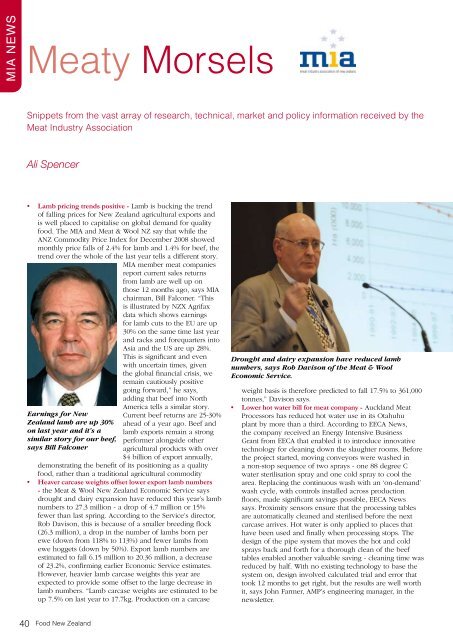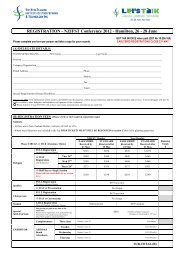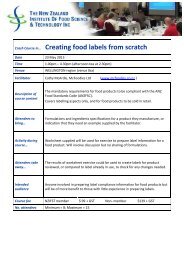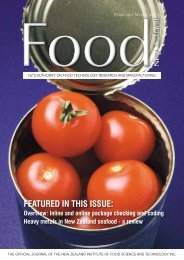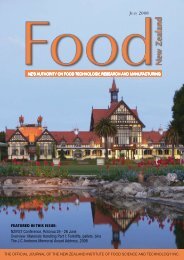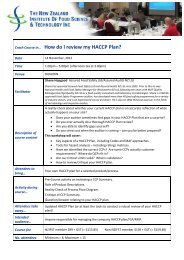featured in this issue - NZIFST - The New Zealand Institute of Food ...
featured in this issue - NZIFST - The New Zealand Institute of Food ...
featured in this issue - NZIFST - The New Zealand Institute of Food ...
Create successful ePaper yourself
Turn your PDF publications into a flip-book with our unique Google optimized e-Paper software.
MIA NEWS<br />
Meaty Morsels<br />
Snippets from the vast array <strong>of</strong> research, technical, market and policy <strong>in</strong>formation received by the<br />
Meat Industry Association<br />
Ali Spencer<br />
• Lamb pric<strong>in</strong>g trends positive - Lamb is buck<strong>in</strong>g the trend<br />
<strong>of</strong> fall<strong>in</strong>g prices for <strong>New</strong> <strong>Zealand</strong> agricultural exports and<br />
is well placed to capitalise on global demand for quality<br />
food. <strong>The</strong> MIA and Meat & Wool NZ say that while the<br />
ANZ Commodity Price Index for December 2008 showed<br />
monthly price falls <strong>of</strong> 2.4% for lamb and 1.4% for beef, the<br />
trend over the whole <strong>of</strong> the last year tells a different story.<br />
MIA member meat companies<br />
report current sales returns<br />
from lamb are well up on<br />
those 12 months ago, says MIA<br />
chairman, Bill Falconer. “This<br />
is illustrated by NZX Agrifax<br />
data which shows earn<strong>in</strong>gs<br />
for lamb cuts to the EU are up<br />
30% on the same time last year<br />
and racks and forequarters <strong>in</strong>to<br />
Asia and the US are up 28%.<br />
This is significant and even<br />
with uncerta<strong>in</strong> times, given<br />
the global f<strong>in</strong>ancial crisis, we<br />
rema<strong>in</strong> cautiously positive<br />
go<strong>in</strong>g forward,” he says,<br />
add<strong>in</strong>g that beef <strong>in</strong>to North<br />
America tells a similar story.<br />
Earn<strong>in</strong>gs for <strong>New</strong> Current beef returns are 25-30%<br />
<strong>Zealand</strong> lamb are up 30% ahead <strong>of</strong> a year ago. Beef and<br />
on last year and it’s a lamb exports rema<strong>in</strong> a strong<br />
similar story for our beef, performer alongside other<br />
says Bill Falconer agricultural products with over<br />
$4 billion <strong>of</strong> export annually,<br />
demonstrat<strong>in</strong>g the benefit <strong>of</strong> its position<strong>in</strong>g as a quality<br />
food, rather than a traditional agricultural commodity<br />
• Heaver carcase weights <strong>of</strong>fset lower export lamb numbers<br />
- the Meat & Wool <strong>New</strong> <strong>Zealand</strong> Economic Service says<br />
drought and dairy expansion have reduced <strong>this</strong> year’s lamb<br />
numbers to 27.3 million - a drop <strong>of</strong> 4.7 million or 15%<br />
fewer than last spr<strong>in</strong>g. Accord<strong>in</strong>g to the Service’s director,<br />
Rob Davison, <strong>this</strong> is because <strong>of</strong> a smaller breed<strong>in</strong>g flock<br />
(26.3 million), a drop <strong>in</strong> the number <strong>of</strong> lambs born per<br />
ewe (down from 118% to 113%) and fewer lambs from<br />
ewe hoggets (down by 50%). Export lamb numbers are<br />
estimated to fall 6.15 million to 20.36 million, a decrease<br />
<strong>of</strong> 23.2%, confirm<strong>in</strong>g earlier Economic Service estimates.<br />
However, heavier lamb carcase weights <strong>this</strong> year are<br />
expected to provide some <strong>of</strong>fset to the large decrease <strong>in</strong><br />
lamb numbers. “Lamb carcase weights are estimated to be<br />
up 7.5% on last year to 17.7kg. Production on a carcase<br />
Drought and dairy expansion have reduced lamb<br />
numbers, says Rob Davison <strong>of</strong> the Meat & Wool<br />
Economic Service.<br />
weight basis is therefore predicted to fall 17.5% to 361,000<br />
tonnes,” Davison says.<br />
• Lower hot water bill for meat company - Auckland Meat<br />
Processors has reduced hot water use <strong>in</strong> its Otahuhu<br />
plant by more than a third. Accord<strong>in</strong>g to EECA <strong>New</strong>s,<br />
the company received an Energy Intensive Bus<strong>in</strong>ess<br />
Grant from EECA that enabled it to <strong>in</strong>troduce <strong>in</strong>novative<br />
technology for clean<strong>in</strong>g down the slaughter rooms. Before<br />
the project started, mov<strong>in</strong>g conveyors were washed <strong>in</strong><br />
a non-stop sequence <strong>of</strong> two sprays - one 88 degree C<br />
water sterilisation spray and one cold spray to cool the<br />
area. Replac<strong>in</strong>g the cont<strong>in</strong>uous wash with an ‘on-demand’<br />
wash cycle, with controls <strong>in</strong>stalled across production<br />
floors, made significant sav<strong>in</strong>gs possible, EECA <strong>New</strong>s<br />
says. Proximity sensors ensure that the process<strong>in</strong>g tables<br />
are automatically cleaned and sterilised before the next<br />
carcase arrives. Hot water is only applied to places that<br />
have been used and f<strong>in</strong>ally when process<strong>in</strong>g stops. <strong>The</strong><br />
design <strong>of</strong> the pipe system that moves the hot and cold<br />
sprays back and forth for a thorough clean <strong>of</strong> the beef<br />
tables enabled another valuable sav<strong>in</strong>g - clean<strong>in</strong>g time was<br />
reduced by half. With no exist<strong>in</strong>g technology to base the<br />
system on, design <strong>in</strong>volved calculated trial and error that<br />
took 12 months to get right, but the results are well worth<br />
it, says John Farmer, AMP’s eng<strong>in</strong>eer<strong>in</strong>g manager, <strong>in</strong> the<br />
newsletter.<br />
40<br />
<strong>Food</strong> <strong>New</strong> <strong>Zealand</strong>


